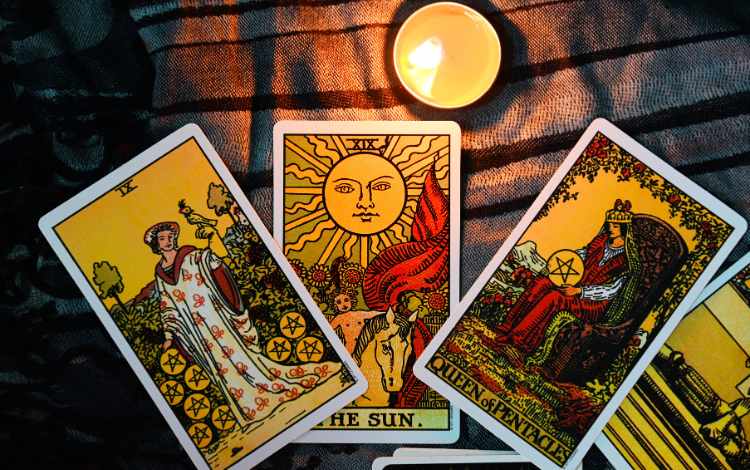
If you’ve ever been attracted to the mysterious charm of tarot cards, you’re not alone. They are a great source to get you closer to the truth and clarity.
Tarot cards have long been used to provide guidance and reflection. However, understanding tarot can seem daunting.
This guide is here to help explore everything from the free tarot card reading process to the tarot decks and their structure. Let’s dive in.
Tarot Basics: The Deck and Its Structure
A tarot deck uses 78 distinct cards to tell its stories. These 78 cards are split into two main sections: the Major Arcana and the Minor Arcana.
Let’s first talk about Major Arcana. It consists of 22 significant cards. Each card symbolizes important events or phases in our spiritual journey. The story starts with The Fool and ends with The World, capturing the essence of life’s spiritual path.
On the other hand, we have the Minor Arcana. It’s a bigger group with 56 cards, and they’re separated into four suits: Cups, Pentacles, Swords, and Wands.
Unlike the Major Arcana, the Minor Arcana focuses on our day-to-day lives. It deals with everyday happenings and personal feelings or influences.
In each suit, you’ll find ten cards with numbers and four additional court cards.
Types of Tarot Decks
Different tarot decks exist, each with unique artwork and themes, yet most retain the core structure of 22 Major Arcana and 56 Minor Arcana.
Typically, the Rider-Waite-Smith deck, known for its clear imagery, is excellent for beginners.
The Thoth Tarot, filled with astrological and magical symbolism, suits experienced readers.
Furthermore, the Marseille Tarot is one of the oldest decks and features a minimalistic design that challenges readers to rely more on their intuition.
How to Choose Your Tarot Deck
Choosing a tarot deck that resonates with you can enhance your tarot reading experience. Here’s a simple guide on how to select your deck:
1. Research Different Decks
Start by familiarizing yourself with various types of decks. Understand their thematic emphasis and appreciate their artistic style.
2. Look for Visual Appeal
The imagery and symbolism of your tarot deck should resonate with you. Look for a deck that captivates your senses and draws you in.
3. Consider the Complexity
Starting with a simpler deck like the Rider-Waite-Smith deck might be beneficial if you’re a beginner. Its clear imagery and narrative will make your initial journey into tarot smoother.
4. Take Your Time
Choosing a tarot deck is a personal process. Don’t rush it. Some believe that your first deck should be a gift. However, it’s perfectly okay to buy one yourself. What matters is that the deck feels right to you and that you connect with it.
Interpreting the Tarot: Meanings and Symbolism
Interpreting tarot is an art that transcends literal meanings. Each card carries rich symbolism rooted in cultural, historical, or mythical references. The cards have upright and reversed meanings,
Offering insights into various situations. However, the meaning can change depending on the context of the question and the reader’s intuition.
For example, The Fool indicates new beginnings when upright but may suggest recklessness when reversed. On the other hand, the Death card signifies transformation and new beginnings instead of physical death.
The Process of Tarot Reading
Tarot reading is an intuitive process. To read a tarot card, begin by formulating a straightforward question or intention, shuffle the deck, and draw the cards.
You can use different spreads, from a one-card draw to complex layouts like the Celtic Cross spread.
Moreover, the position of each card in the spread and the surrounding cards influence its interpretation, creating a narrative thread in the reading.
Examples of Tarot Cards
If you’re new to tarot, some practical examples can help you grasp the layered meanings of the cards. Let’s consider a few cards from the widely-adopted Rider-Waite-Smith deck:
The Magician: When upright, The Magician symbolizes power, manifestation, and resourcefulness. It’s a positive indicator of your innate ability to achieve your objectives. However, when reversed, The Magician could imply manipulation or trickery.
The High Priestess: The High Priestess is upright and embodies intuition, mystery, and a subconscious mind. It’s a reminder to trust your instincts. However, this card may represent withheld secrets or a disconnect from intuition in its reversed state.
The Hermit: In its upright position, It suggests introspection, soul-searching, and the pursuit of inner guidance. It’s a card for personal growth through solitude. Reversed, it can hint at excessive isolation or withdrawal from the world.
Ten of Swords: A card from the Minor Arcana, the Ten of Swords, when upright, signifies painful endings or deep wounds, indicating a challenging situation reaching its lowest point. Yet, it also signals the end of this tough cycle. In reverse, it might imply resilience, recovery, or a fear of disaster.
Conclusion
Understanding tarot card reading is like learning a new language that speaks in symbols, images, emotions, and experiences. It offers a mirror to our subconscious thoughts and feelings.
The path to mastering tarot may seem complicated, filled with symbolism and mystery, but each step brings you closer to personal insights and growth.
With various tarot decks available, each with its unique charm and complexity, you can choose the one that resonates most with you.
So, whether you’re seeking guidance, self-awareness, or merely intrigued by the mystical world of tarot, the cards hold a conversation with you.